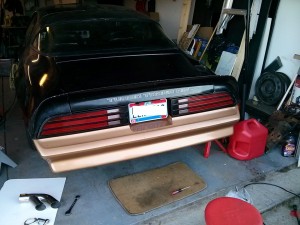September was an exciting month for Project Trans Am. With summer coming to a close, we finally got the motor started and broken in!
Engine Break-in
Labor Day morning between 9am and 1pm was our scheduled break-in time with Joel. Before we broke in the motor, we did all the normal work priming the motor, setting the distributor and running the spark plug wires. The wires I got are molded specifically for a Pontiac V8. It took a few swaps before we finally got the right lengths to the correct cylinders. After checking fluids, we were ready to go. Unfortunately this ate up a good 3 of our 4 hours.
You know the saying, second time is a charm? Well that applies with the engine break-in too! When we tried to start the motor, it back fired once, then we had a fuel leak. Then after fixing all the little problems, we just never got any spark. We had limited time available due to the labor day holiday, so we had to put off getting her started till Tuesday. That night though I discovered we did not have the distributor shaft pointing at the number one spark plug wire on the distributor cap. That night I repositioned the distributor so we were ready to go the next day. You can see from the pictures, we were off a good 150+ degrees.
The next morning Joel came over, within 10 minutes we had the motor fired up and in break-in mode. We let it run for 30 minutes between 2,000 and 3,000 rpm, not keeping it too long on one particular rpm. then once we were done, we got the idle set at about 700 rpm.
The Good News
The engine runs strong! Touching the gas pedal, she responds instantly. The exhaust sounds really good, inside noise is low thanks to the deadener on the floors, and all the electronics, gauges and switches appear to be working properly. Electrical wise, the only problem I saw was with the dome light flickering when the door was open. I never tested the door jam switches, so hopefully they are just worn out and replacements will fix that problem. Otherwise, the car electrical is good to go! Water temperature was right at 190 degrees, which is perfect. I am running a 180 degree thermostat, so this is right on par with what I wanted temperature wise. Everything was better than I expected, except for the oil pressure.
Last year I was able to test all of the gauges except for the tachometer. I am happy to report the tachometer works! it appears to be off by about 200 rpm, but that’s acceptable. Even the brake light, choke light and seat belt lights worked!
Low Oil Pressure!
During engine break-in, oil pressure was between 30-40psi, which is ok. But when we were done and started setting the engine for idle, we noticed oil pressure was below 10 when the RPMs hovered down around 700. We promptly turned off the motor, let it cool, then changed the oil filter and 30 weight break-in oil with 20W50 (the weight motor oil I plan on running). Cold oil pressure is strong at 65psi, but once it was warmed up, pressure at idle was at about 15 psi. revving the engine increases oil pressure, at 2,000 rpm I see about 25-30psi, and close to 3,000 rpm I am seeing about 35-40psi. So the oil pressure problem appears to be related to idle. I expected to see 20psi at idle with 10psi added for every 1,000 rpm.
The following week Joel came over and helped me pull the motor to replace the oil pump to see if we can get that oil pressure up where it should be.
I decided to take the motor and new oil pump to DCI Motorsports to replace the oil pump with a blueprinted pump. At this point I am pretty pleased with my engine building skills, but in the future, I will have my engines built so all I have to do is install top-end components and focus on the other car details.
Taillights and Rear Bumper Installed
The rear taillights are now wired, mounted and ready to go! Switching from a 79-81 rear bumper to a 77/78 style is not a simple task. There are many ways to approach the problem. One way is to replace the entire tail panel with an older tail panel so the taillights mount right up (this way is requires a lot of body work). A second option is to drill new holes into the existing tail panel to allow for the older taillights to mount to (simplest way, but modifies the tail panel). The third option (which I did) was create brackets on the taillights to relocate the studs to line up with the existing 79-81 tail panel (leaves the tail panel unmodified). This was a time consuming task that involved 3/16″ thick aluminum stock, a lot of tapping and threading, and even more patience. the result is what you see, without taking the taillights off you would not be able to tell it’s bolted to a 1981 tail panel.
In the short time I had, I put a few light coats of Krylon Fusion gloss black paint on the taillight frames. Next year I will take them off and properly paint them, but for now it’s better than what they looked like before.
What’s Next?
October and November I will be switching gears and working on the house before winter sets in. I may get to do a little wrenching here/there, but it will be minimal. Hopefully I will get the motor back from DCI before Christmas so I can get the remaining front fenders, front bumper and hood installed and finally take her for a spin before the first snow fall!









